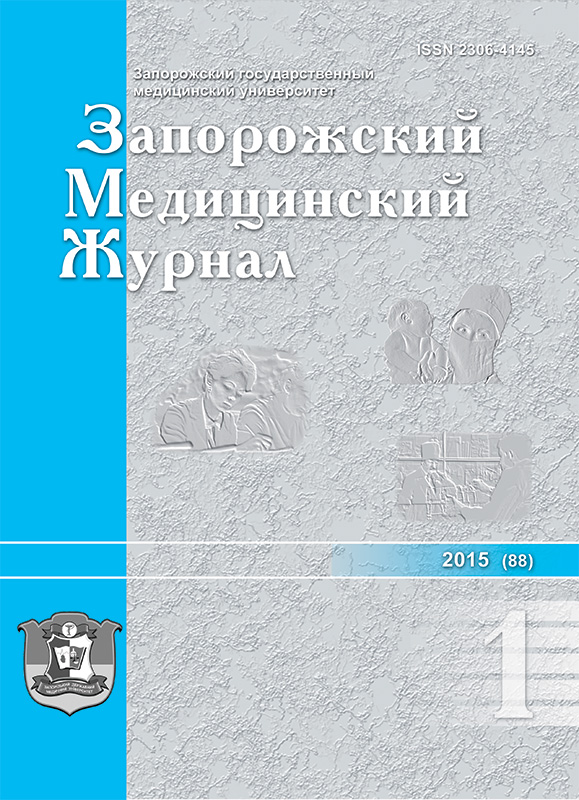Method for radical surgical treatment of lower limbs varicose disease
DOI:
https://doi.org/10.14739/2310-1210.2015.1.39199Keywords:
Varicose Veins, Treatment, PhlebectomyAbstract
Aim. To develop a less traumatic method of surgical treatment of the lower extremities (VVLE).
Methods and results. Known method of radical treatment of varicose veins of the VVLE is the single-step execution of the phlebectomy of the large and small v. subcutaneous trunk, collaterals with subfascial ligation of perforating veins. But the method is highly traumatic. For the purpose to develop a less traumatic method of surgical treatment of the VVLE, 97 patients VVLE C2-C6 were examined with CEAP. Radical way of surgical treatment of the VVLE was developed. Components of the proposed operation are: crossectomy, short stripping of the trunk of v. subcutaneous major with removal of Boyd perforants, mini-phlebectomia by Muller.
Conclusion. It was established that the method has a smaller injuries and operative time, allows to save unaltered subcutaneous veins, have better cosmetic effect that testifies the advisability of the proposed method of treatment.
References
Ramele, A.-A., Kern, F., & Perin M. (2008) Varikoznye veny i teleangioe`ktazii [Varicose veins and telangiectasias]. Moscow: MEDpress-inform. [in Russian].
Savel'ev, J. V., Dumpe, Е`. P., & Yablokov, E. G. (1972). Bolezni magistral'nykh ven [Diseases of the main veins]. Moscow: Medicine. [in Russian].
Usenko, O. Yu., Nіkulnіkov, P. І., & Chernukha, L. M. (2014). Khronichni zakhvoriuvannia ven nyzhnikh kintsivok i taza: diahnostyka, terapiia, likarsko-trudova ekspertyza, profilaktyka uskladnen: kliniko-praktychni rekomendatsii [Clinical and practical recommendations Chronic diseases of veins of the lower extremities and pelvis: diagnosis, therapy, medical and labor inspection, prevention of complications]. Kyiv. [in Ukrainian].
Palamarchuk, V., Smorzhevskij, V., & Hodos, V. (2010). Nevrologicheskie oslozhneniya posle operacii na venakh nizhnikh konechnostej [Neurological complications after surgery on the veins of the lower extremities]. Khirurhiia Ukrainy, 4, 53–57. [in Ukrainian].
Kaplan, R., Criqui, M., Denenberg, J., Bergan, J., & Fronek, A. (2003). Quality of life in patients with chronic venous disease: San Diego population study. Journal of Vascular Surgery, 37(5), 1047–1053. doi:10.1067/mva.2003.168.
Eklof, B., Perrin, M., Delis, K., Rutherford, R., & Gloviczki, P. (2009). Updated terminology of chronic venous disorders: The VEIN-TERM transatlantic interdisciplinary consensus document. Journal of Vascular Surgery, 49(2), 498–501. doi: 10.1016/j.jvs.2008.09.014.
Rabe, E., & Panier, F. (2009). Epidemiology of chronic venous disorders Handbook of venous disorders: guidelines of the American Venous Forum. P. Gloviczki (Ed.). London: Hodder Arnold.
Holme, J., Skajaa, K., & Holme, K. (1990). Incidence of lesions of the saphenous nerve after partial or complete stripping of the long saphenous vein. Acta Chir. Scandin, 156, 145–148.
Rasmussen, L., Bjoern, L., Lawaetz, M., Lawaetz, B., Blemings, A., & Eklöf, B. (2010). Randomised Clinical Trial Comparing Endovenous Laser Ablation with Stripping of the Great Saphenous Vein: Clinical Outcome and Recurrence After 2Years. European Journal of Vascular and Endovascular Surgery, 39(5), 630–635. doi: 10.1016/j.ejvs.2009.11.040.
Downloads
How to Cite
Issue
Section
License
Authors who publish with this journal agree to the following terms:
- Authors retain copyright and grant the journal right of first publication with the work simultaneously licensed under a Creative Commons Attribution License that allows others to share the work with an acknowledgement of the work's authorship and initial publication in this journal.

- Authors are able to enter into separate, additional contractual arrangements for the non-exclusive distribution of the journal's published version of the work (e.g., post it to an institutional repository or publish it in a book), with an acknowledgement of its initial publication in this journal.
- Authors are permitted and encouraged to post their work online (e.g., in institutional repositories or on their website) prior to and during the submission process, as it can lead to productive exchanges, as well as earlier and greater citation of published work (See The Effect of Open Access)

